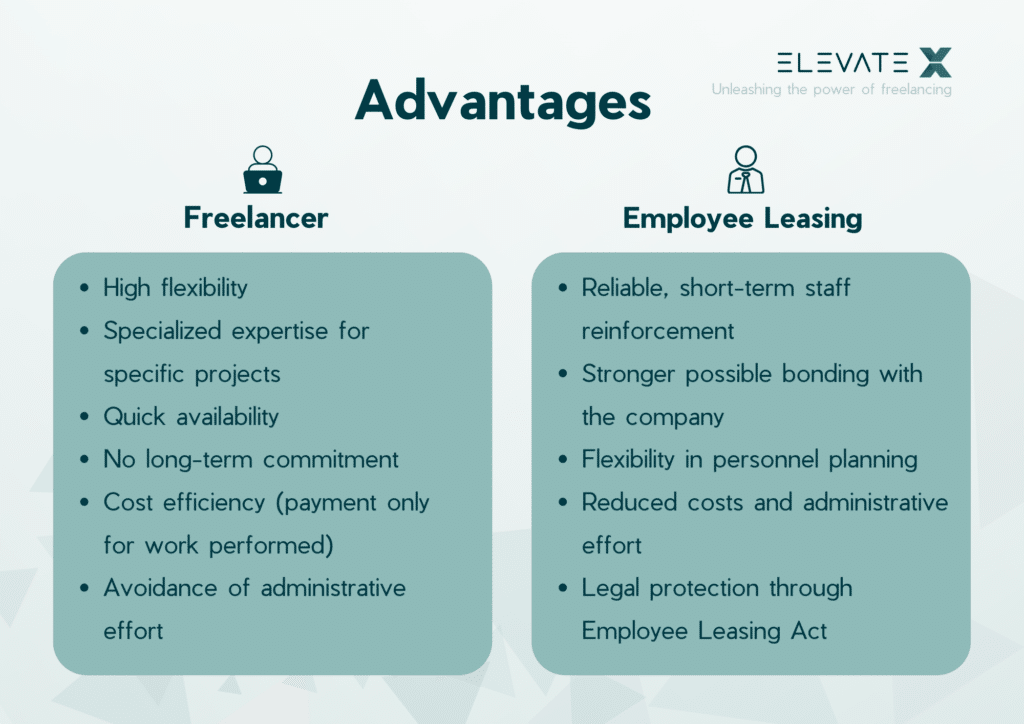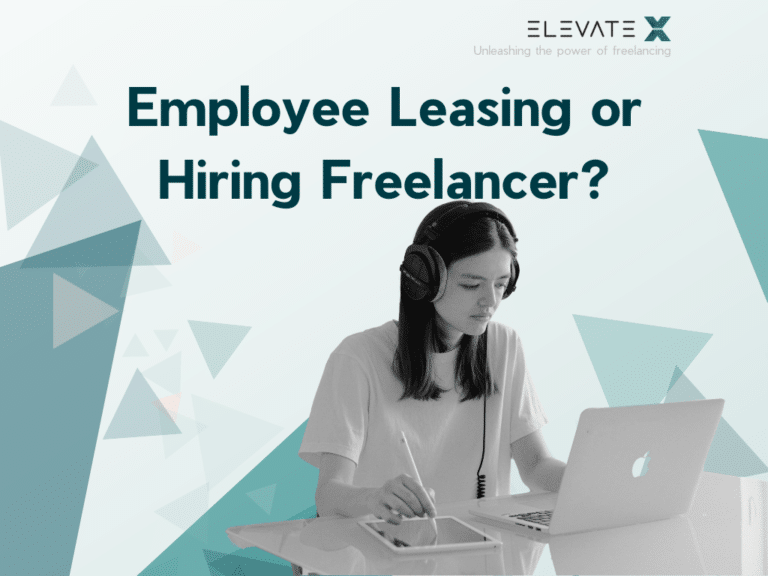Many companies are currently experiencing personnel bottlenecks due to a good order situation. Skilled workers are scarce anyway. Therefore, new concepts for project execution are needed. Depending on the industry, size, and area of application, companies use different mediation methods. The need for skilled workers is particularly pronounced in the IT industry. If a company needs additional skilled workers at short notice, there are two options:
- Use of Freelancers
- Employee Leasing
In this article, you will learn about the advantages and disadvantages of both the concepts of employee leasing and freelancers.
What are Freelancers?
Freelancers work independently. Often, they work for multiple clients simultaneously. What is the difference between freelancers and freelancers? You can find the answer in our blog.
KEY POINTS
- Freelancers are ideal for short-term projects and offer flexibility as well as specialized knowledge without lengthy hiring processes.
- Employee leasing is suitable for short-term staffing needs, with lower risks and administrative effort for the company.
- While freelancers offer more flexibility and lower costs, employee leasing ensures a more stable commitment and avoids the risk of back payments for social security contributions.
Support Through Freelancers
Companies hire trained freelancers to deploy them for a specific project. They pay for the services rendered with a flat-rate fee or a compensation according to the number of hours worked.
When Do Freelancers Pay Off for a Company?
Hiring freelancers is suitable for companies with short-term peaks in orders or personnel bottlenecks. The commissioning company can use freelancers in projects that are currently important or urgent. Independent experts have extensive experience and are familiar with similar projects. IT infrastructure and IT applications are continuously developing. What are IT services? You will find the answer in our blog. Do you want to know which digital competencies are required for a successful digitalization strategy? You will find valuable tips in our blog.
No Lengthy Search and Hiring Processes
Hiring IT freelancers is uncomplicated and cost-effective. Lengthy search and hiring processes are avoided. IT freelancers can often advance projects with their expertise within a short time, solve a problem or achieve a first milestone. Do you want to know how freelancer onboarding works in six easy steps? You can find out on our site.
We Are the Go-to Contact for Freelancers and Employee Leasing.
No Costs in Case of Illness
If a freelancer you have hired becomes ill during the project and is absent for several days, no fee is paid. As an entrepreneur, you only pay for the actual hours worked. Thus, vacation days also remain unpaid. In addition, no employer contributions to social security are due. The freelancer is responsible for paying his social contributions and taxes from the received fee. What insurance do freelancers need? We clarify this question in our blog.
Kriterien der Scheinselbstständigkeit beachten
It is important that companies observe the criteria for false self-employment. What false self-employment is and how it can be avoided, can be learned in our article.
Competitive Advantages Through Fast Personnel Recruitment
With fast personnel recruitment, companies gain a competitive advantage. What does “time-to-hire” mean and what do freelancers have to do with it? You will get the answer in our blog.
Freelancer Advantages at a Glance
- Freelancers are available very quickly.
- No long-term commitment
- Fast response to order fluctuations possible
- Companies benefit from the freelancers’ further training.
- Only the work actually performed is remunerated.
Freelance Platforms for IT Professionals
For many qualified IT professionals, flexibility is an important criterion. Therefore, numerous experts use professional freelance platforms. What were the top 5 freelance platforms in 2023? You can see the ranking in our blog.

What is Employee Leasing?
Employee leasing is also known as personnel leasing or temporary work. The legal basis is the Employee Leasing Act (AÜG). This form of employment was introduced to enable companies to react to short-term fluctuations in orders.
Definition of Employee Leasing
An employee is lent by an employer to a third party for a limited period of time for a fee.
How Does Employee Leasing Work?
Companies communicate their requirements to the personnel service agency. The service provider accesses a large pool of profiles. A contract is concluded as soon as a suitable skilled worker is found. This worker is then lent to the company for the agreed period.
Contractual Relationships in Employee Leasing
A temporary contract is concluded between the personnel agency (the lender) and the commissioning company (the borrower). The personnel service provider assumes the role of the employer. The relationship between the personnel agency and the worker is regulated in a written contract. Consequently, there is no contractual relationship between the worker and the company where they are deployed.
Remuneration and Fees
The commissioning company pays the personnel agency a fixed amount in return for the employee leasing. The personnel agency remunerates the lent skilled worker and retains the remaining amount as a fee for the personnel service. The personnel agency is responsible for approving vacation requests.
When Does Employee Leasing Pay Off?
Employee leasing pays off when a company needs specialized skilled workers at short notice for ongoing or planned projects.
Advantages of Employee Leasing for Companies
For the company, costs are only incurred for the actual working hours of the employees. The commissioning company does not need to pay social contributions, but only the agreed hourly rate.
Advantages of Employee Leasing at a Glance
- Flexibility
- Planning with a short lead time possible
- Low risks in personnel procurement
- Low administrative effort
- Lower costs
- Transparency regarding the required working hours
Employee Leasing Act as Legal Basis
More information about the Employee Leasing Act can be found on the website of the Federal Ministry of Labour and Social Affairs.
Contents of the Employee Leasing Contract
- Permission for employee leasing
- Obligation to report an extension or termination of the employee leasing
- Required qualification of the temporary worker
- Special requirements for the activity
- Working conditions
- Remuneration regulation
Maximum Duration of Employee Leasing
The leasing of temporary workers is time-limited. The maximum duration for a company is 18 months. A longer leasing is generally only permissible if it is interrupted for a period of at least three months and one day. An absence due to vacation or illness does not count as an interruption in this context. The termination of the employee leasing contract is required.
Equal Pay Principle
According to the Equal Pay principle, temporary workers are paid the same as comparable permanent staff of the commissioning company. Deviations are possible if the skilled worker is deployed in a company with a valid industry surcharge tariff. Further information on the industry surcharges in the individual sectors can be found on the website of the Federal Employers‘ Association of Personnel Service Providers.
Back Payment of Social Contributions
If social insurance liability is subsequently determined, the employer must pay back the social contributions. In addition, penalty payments are due.
Relief Through AI and Software
In times of scarce skilled workers, many companies are using artificial intelligence to relieve their teams. What are the 9 best free AI chatbots? You can find out in our blog. Project management software also contributes to relief in administration. What are the best free project management software? You will find valuable tips in our blog.
Freelancers and Employee Leasing in Comparison
- With freelancers, even more flexibility is given.
- With freelancers, the costs are lower.
- Binding to the company is better possible with employee leasing.
- With employee leasing, the risk of back payment of social contributions is eliminated.
Conclusion
Employee leasing or freelancers? In the IT industry, both freelancers and temporary workers are increasingly in demand. Both concepts are cost-efficient because the time-consuming recruiting process is eliminated.
Freelancers are hired for a limited period to undertake a specific task or project in the company.
Employee leasing means: An employee is lent by a personnel service provider to a third party for a limited period for a fee. The employer is the lender. The commissioning company is the borrower.
The lack of legal certainty regarding retrospective social insurance contributions is a relevant argument for employee leasing. Otherwise, freelancers are the suitable solution.








